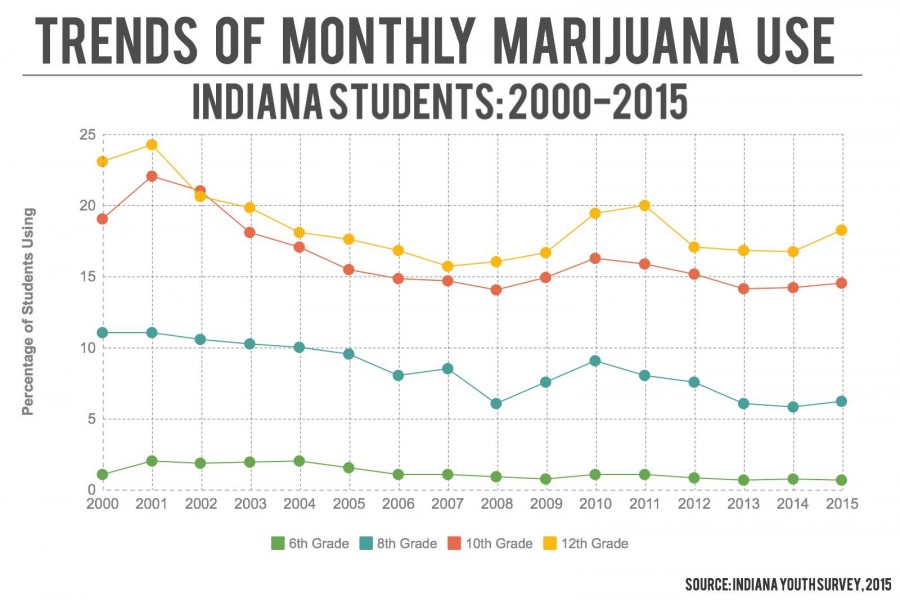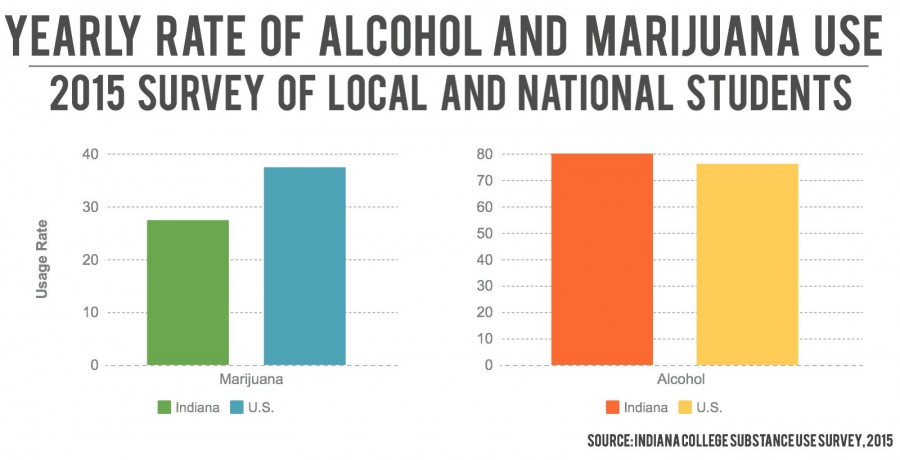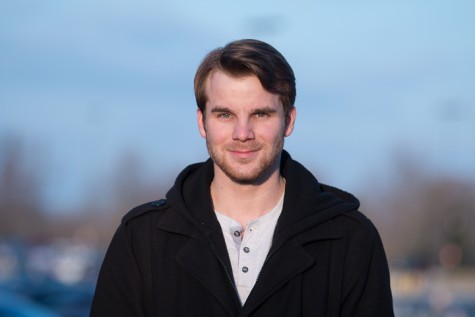Rising smoke
Marijuana and alcohol use rising among Indiana college students.
February 22, 2016
Incidents involving the use of drug and alcohol on campus have resulted in multiple police dispatches in recent weeks at IU Southeast.
One call on Wednesday, Jan. 27 resulted in two non-students being cited for possession of alcohol and marijuana after they were caught with the substances while visiting friends who live in the lodges, according to a police blotter from IUS Police.
In 2014, 14 arrests were made on campus for alcohol or drug-related crimes, according to the Annual Security Report released by IUS. A higher amount of incidents did not result in arrests, but were reported to university officials for disciplinary action, with 41 incidents involving alcohol and three involving drugs.
Charles Edelen, IUS chief of police, said while calls to the lodges happen often, he does not believe it is occurring at an excessive rate.
“We catch kids every semester smoking marijuana,” Edelen said. “I wouldn’t say it’s going on any more this semester than any other semester. We’re on a college campus, and it’s becoming more commonplace around the country. I don’t see it as too big of an issue.”
Though Edelen said the situation is relatively calm at IUS, studies show reported usage of marijuana has gone up on college campuses across the country.
A report released in September 2015 by the University of Michigan’s Monitoring the Future study indicated that daily usage of marijuana is at its highest rate since 1980. Surveys revealed that about 1 in 17 students are smoking marijuana on a daily basis, a number that has nearly doubled since 2007.
Another data set gathered through the Indiana College Substance Use Survey for 2015 showed that 27.7 percent of college students in the state used marijuana in the previous year, which was slightly lower than the national rate of 34.4 percent.
The survey showed alcohol was consumed by 80 percent of students, compared to 76.1 percent nationally. Also, 71.3 percent of students under the age of 21 reported drinking alcohol on at least one occasion in the previous year.
MeriBeth Adams-Wolf, executive director at Our Place Drug and Alcohol Services and adjunct instructor of at IUS, said the rates at which young people are using alcohol and marijuana present a problem.
“We see the highest rates of alcohol abuse in that population between 18 and 25, which is the college population,” Adams-Wolf said. “That’s where they start the drinking habits. I think we see the same thing with marijuana. I think that this population becomes at risk because of that, more so than just the general population.”
The Indiana Youth Use Survey conducted by the Indiana Prevention Resource Center for 2015 showed that approximately 1 in 5 students in grade 12 used marijuana at least once a month in 2015. In some southern Indiana counties, the ratio rises to 1 in 3. In relion to past years, the rates at which students are using show an upward trend.
“The data that we’ve got for Floyd County in particular shows that we have higher rates of marijuana smoking than other counties around us,” Adams-Wolf said. “We’re higher than the state rate. You can correlate it to the fact that a majority of the young population think it’s harmless.”
Adams-Wolf said this can be attributed largely to a lack of perception of harm associated with using marijuana.
“People tend to stick their head in the sand with this issue and act like it’s a phase or believe it’s like this everywhere,” Adams-Wolf said. “What we find out, specifically when you look at our data compared to other counties in the state of Indiana, is that it’s not like this everywhere. We do have higher rates of substance abuse than other places.”
Adams-Wolf explained that with abuse of prescription drugs, opiates and methamphetamines, the negative consequences of abuse come much sooner and more aggressively than other drugs.
“Because of the quick damage to things such as family and work life, there doesn’t seem to be as much tolerance,” Adams-Wolf said. “If you take the same situation and it’s a person who’s an alcoholic or who uses marijuana, there doesn’t seem to be that same sense of immediacy that there will be consequences with that, even though there could be. They kind of get shoved under the rug a little bit better, and they happen in a longer time frame.”
One incident involving marijuana in the area resulted in much more damage than tickets or arrests. In December 2015, a 24 year-old Lanesville man was murdered in what investigators believe was a drug deal gone wrong.
According to WLKY, the crime occurred at around 3 a.m. in the parking lot of Waffle House near downtown New Albany. The victim was shot after two men attempted to rob him during a marijuana deal.
Floyd County Prosecutor Keith Henderson talked to WLKY reporters after the shooting.
“I see, hear and am involved in the discussions, how this is a particular drug that is harmless,” Henderson said. “In this particular case, it resulted in the murder of Mr. Fischbach [the victim].”
Edelen said statewide laws regarding marijuana have been changed in recent years.
“They didn’t decriminalize it, but they reduced the penalties,” he said. “It’s not legal, but it’s not as illegal as it was before.”
According to Indiana state law, small amounts of marijuana will not affect first-time offenders as harshly as before. An individual without previous offenses would be charged with a Class B misdemeanor, which could result in up to $1,000 in fines and/or 180 days in jail.
“Whether they intended to or not, I think changing the laws and reducing the penalties makes it more acceptable for people that may not have done it before because they knew they might go to jail,” Edelen said. “It’s still possible [to go to jail] but it takes a larger quantity to get there. I think that does impact some people’s decision on whether they’re going to do it or not.”
Legislation shows that four states and the District of Columbia have legalized the recreational use of marijuana. Also, in 2013, the Hoosier Survey showed that 52 percent of Indiana residents supported regulating marijuana similarly to alcohol and tobacco.
Adams-Wolf said she does not believe legalization is the correct solution to the problem. “It is concerning because they’ll rationalize and try to say why it’s okay,” she said. “Just like with alcohol, there are some people who can use and stay within the boundaries of general societal norms. There are other people, though, who once they start can’t seem to get a handle.”
According to statistics released by the FBI, nearly half of all drug arrests in 2014 were marijuana related. Also, a report released by the American Civil Liberties Union showed large amounts of money have been spent on enforcing marijuana laws, with states spending a collective $3.6 billion annually.
Though it is unlikely that marijuana will be legal at the state level any time soon, a number of bills related to legalizing or decriminalizing certain forms of the drug are currently pending in Indiana. ■




